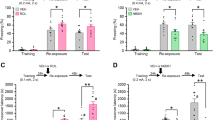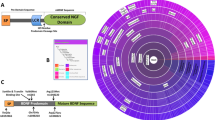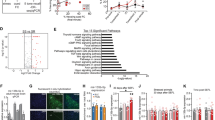Abstract
Females are more likely than males to develop post-traumatic stress disorder (PTSD). However, the neurobiological mechanisms responsible for these sex differences remain elusive. The ubiquitin proteasome system (UPS) is involved in fear memory formation and implicated in PTSD development. Despite this, proteasome-independent functions of the UPS have rarely been studied in the brain. Here, using a combination of molecular, biochemical, proteomic, behavioral, and novel genetic approaches, we investigated the role of proteasome-independent lysine-63 (K63)-polyubiquitination, the second most abundant ubiquitin modification in cells, in the amygdala during fear memory formation in male and female rats. Only females had increased levels of K63-polyubiquitination targeting in the amygdala following fear conditioning, which targeted proteins involved in ATP synthesis and proteasome function. CRISPR-dCas13b-mediated knockdown of K63-polyubiquitination in the amygdala via editing of the K63 codon in the major ubiquitin gene, Ubc, impaired fear memory in females, but not males, and caused a reduction in learning-related increases in ATP levels and proteasome activity in the female amygdala. These results suggest that proteasome-independent K63-polyubiquitination is selectively involved in fear memory formation in the female amygdala, where it is involved in the regulation of ATP synthesis and proteasome activity following learning. This indicates the first link between proteasome-independent and proteasome-dependent UPS functions in the brain during fear memory formation. Importantly, these data are congruent with reported sex differences in PTSD development and may contribute to our understanding of why females are more likely to develop PTSD than males.
This is a preview of subscription content, access via your institution
Access options
Subscribe to this journal
Receive 12 print issues and online access
$259.00 per year
only $21.58 per issue
Buy this article
- Purchase on Springer Link
- Instant access to full article PDF
Prices may be subject to local taxes which are calculated during checkout





Similar content being viewed by others
References
Christiansen DM, Berke ET. Gender- and sex-based contributors to sex differences in PTSD. Curr Psychiatry Rep. 2020;22:19.
Bedford L, Paine S, Sheppard PW, Mayer RJ, Roelofs J. Assembly, structure, and function of the 26S proteasome. Trends Cell Biol. 2010;20:391–401.
Hegde AN. The ubiquitin-proteasome pathway and synaptic plasticity. Learn Mem. 2010;17:314–27.
Livneh I, Cohen-Kaplan V, Cohen-Rosenzweig C, Avni N, Ciechanover A. The life cycle of the 26S proteasome: from birth, through regulation and function, and onto its death. Cell Res. 2016;26:869–85.
Akutsu M, Dikic I, Bremm A. Ubiquitin chain diversity at a glance. J Cell Sci. 2016;129:875–80.
Dikic I, Wakatsuki S, Walters KJ. Ubiquitin-binding domains - from structures to functions. Nat Rev Mol Cell Biol. 2009;10:659–71.
Glickman MH, Ciechanover A. The ubiquitin-proteasome proteolytic pathway: destruction for the sake of construction. Physiol Rev. 2002;82:373–428.
Grice GL, Nathan JA. The recognition of ubiquitinated proteins by the proteasome. Cell Mol Life Sci. 2016;73:3497–506.
Hershko A, Ciechanover A. The ubiquitin system. Annu Rev Biochem. 1998;67:425–79.
Devulapalli R, Jones N, Farrell K, Musaus M, Kugler H, McFadden T, et al. Males and females differ in the regulation and engagement of, but not requirement for, protein degradation in the amygdala during fear memory formation. Neurobiol Learn Mem. 2021;180:107404.
Devulapalli RK, Nelsen JL, Orsi SA, McFadden T, Navabpour S, Jones N, et al. Males and Females Differ in the Subcellular and Brain Region Dependent Regulation of Proteasome Activity by CaMKII and Protein Kinase A. Neuroscience. 2019;418:1–14.
Farrell K, Musaus M, Navabpour S, Martin K, Ray WK, Helm RF, et al. Proteomic Analysis Reveals Sex-Specific Protein Degradation Targets in the Amygdala During Fear Memory Formation. Front Mol Neurosci. 2021;14:716284.
Martin K, Musaus M, Navabpour S, Gustin A, Ray WK, Helm RF, et al. Females, but not males, require protein degradation in the hippocampus for contextual fear memory formation. Learn Mem. 2021;28:248–53.
Musaus M, Farrell K, Navabpour S, Ray WK, Helm RF, Jarome TJ. Sex-specific linear polyubiquitination is a critical regulator of contextual fear memory formation. Front Behav Neurosci. 2021;15:709392.
Dulka BN, Trask S, Helmstetter FJ. Age-related memory impairment and sex-specific alterations in phosphorylation of the Rpt6 Proteasome subunit and Polyubiquitination in the basolateral Amygdala and medial prefrontal cortex. Front Aging Neurosci. 2021;13:656944.
Erpapazoglou Z, Walker O, Haguenauer-Tsapis R. Versatile roles of k63-linked ubiquitin chains in trafficking. Cells. 2014;3:1027–88.
Lee BL, Singh A, Mark Glover JN, Hendzel MJ, Spyracopoulos L. Molecular Basis for K63-Linked Ubiquitination Processes in Double-Strand DNA Break Repair: A Focus on Kinetics and Dynamics. J Mol Biol. 2017;429:3409–29.
Nathan JA, Kim HT, Ting L, Gygi SP, Goldberg AL. Why do cellular proteins linked to K63-polyubiquitin chains not associate with proteasomes? EMBO J. 2013;32:552–65.
Cox DBT, Gootenberg JS, Abudayyeh OO, Franklin B, Kellner MJ, Joung J, et al. RNA editing with CRISPR-Cas13. Science. 2017;358:1019–27.
Melfi R, Cancemi P, Chiavetta R, Barra V, Lentini L, Di Leonardo A. Investigating REPAIRv2 as a Tool to Edit CFTR mRNA with Premature Stop Codons. Int J Mol Sci. 2020;21:4781.
Jarome TJ, Perez GA, Webb WM, Hatch KM, Navabpour S, Musaus M, et al. Ubiquitination of Histone H2B by Proteasome Subunit RPT6 Controls Histone Methylation Chromatin Dynamics During Memory Formation. Biol Psychiatry. 2021;89:1176–87.
Jarome TJ, Kwapis JL, Ruenzel WL, Helmstetter FJ. CaMKII, but not protein kinase A, regulates Rpt6 phosphorylation and proteasome activity during the formation of long-term memories. Front Behav Neurosci. 2013;7:115.
Jarome TJ, Werner CT, Kwapis JL, Helmstetter FJ. Activity dependent protein degradation is critical for the formation and stability of fear memory in the amygdala. PLoS One. 2011;6:e24349.
Orsi SA, Devulapalli RK, Nelsen JL, McFadden T, Surineni R, Jarome TJ. Distinct subcellular changes in proteasome activity and linkage-specific protein polyubiquitination in the amygdala during the consolidation and reconsolidation of a fear memory. Neurobiol Learn Mem. 2019;157:1–11.
Johansen JP, Cain CK, Ostroff LE, LeDoux JE. Molecular mechanisms of fear learning and memory. Cell. 2011;147:509–24.
Zalcman G, Federman N, Romano A. CaMKII isoforms in learning and memory: Localization and function. Front Mol Neurosci. 2018;11:445.
Ohtake F, Tsuchiya H, Saeki Y, Tanaka K. K63 ubiquitylation triggers proteasomal degradation by seeding branched ubiquitin chains. Proc Natl Acad Sci USA. 2018;115:E1401–e1408.
Bauer EP, Schafe GE, LeDoux JE. NMDA receptors and L-type voltage-gated calcium channels contribute to long-term potentiation and different components of fear memory formation in the lateral amygdala. J Neurosci. 2002;22:5239–49.
Jarome TJ, Helmstetter FJ. The ubiquitin-proteasome system as a critical regulator of synaptic plasticity and long-term memory formation. Neurobiol Learn Mem. 2013;105:107–16.
López AJ, Hecking JK, White AO. The Emerging Role of ATP-dependent chromatin remodeling in memory and substance use disorders. Int J Mol Sci. 2020;21:6816.
Rangaraju V, Calloway N, Ryan TA. Activity-driven local ATP synthesis is required for synaptic function. Cell. 2014;156:825–35.
Rodrigues SM, Schafe GE, LeDoux JE. Intra-amygdala blockade of the NR2B subunit of the NMDA receptor disrupts the acquisition but not the expression of fear conditioning. J Neurosci. 2001;21:6889–96.
Wang CM, Yang YJ, Zhang JT, Liu J, Guan XL, Li MX, et al. Regulation of emotional memory by hydrogen sulfide: role of GluN2B-containing NMDA receptor in the amygdala. J Neurochem. 2015;132:124–34.
Nakazawa T, Komai S, Watabe AM, Kiyama Y, Fukaya M, Arima-Yoshida F, et al. NR2B tyrosine phosphorylation modulates fear learning as well as amygdaloid synaptic plasticity. EMBO J. 2006;25:2867–77.
Delawary M, Tezuka T, Kiyama Y, Yokoyama K, Inoue T, Hattori S, et al. NMDAR2B tyrosine phosphorylation regulates anxiety-like behavior and CRF expression in the amygdala. Mol Brain. 2010;3:37.
Sun YY, Cai W, Yu J, Liu SS, Zhuo M, Li BM, et al. Surface expression of hippocampal NMDA GluN2B receptors regulated by fear conditioning determines its contribution to memory consolidation in adult rats. Sci Rep. 2016;6:30743.
Cullen PK, Ferrara NC, Pullins SE, Helmstetter FJ. Context memory formation requires activity-dependent protein degradation in the hippocampus. Learn Mem. 2017;24:589–96.
Dulka BN, Pullins SE, Cullen PK, Moyer JR Jr., Helmstetter FJ. Age-related memory deficits are associated with changes in protein degradation in brain regions critical for trace fear conditioning. Neurobiol Aging. 2020;91:160–6.
Lopez-Salon M, Alonso M, Vianna MR, Viola H, Mello e Souza T, Izquierdo I, et al. The ubiquitin-proteasome cascade is required for mammalian long-term memory formation. Eur J Neurosci. 2001;14:1820–6.
Rosenberg T, Elkobi A, Rosenblum K. mAChR-dependent decrease in proteasome activity in the gustatory cortex is necessary for novel taste learning. Neurobiol Learn Mem. 2016;135:115–24.
Keiser AA, Turnbull LM, Darian MA, Feldman DE, Song I, Tronson NC. Sex differences in context fear generalization and recruitment of hippocampus and Amygdala during retrieval. Neuropsychopharmacology. 2017;42:397–407.
Dachtler J, Fox KD, Good MA. Gender specific requirement of GluR1 receptors in contextual conditioning but not spatial learning. Neurobiol Learn Mem. 2011;96:461–7.
Huo Y, Khatri N, Hou Q, Gilbert J, Wang G, Man HY. The deubiquitinating enzyme USP46 regulates AMPA receptor ubiquitination and trafficking. J Neurochem. 2015;134:1067–80.
Beamish SB, Frick KM. A putative role for Ubiquitin-Proteasome signaling in estrogenic memory regulation. Front Behav Neurosci. 2021;15:807215.
Holehonnur R, Phensy AJ, Kim LJ, Milivojevic M, Vuong D, Daison DK, et al. Increasing the GluN2A/GluN2B Ratio in Neurons of the Mouse Basal and Lateral Amygdala Inhibits the Modification of an Existing Fear Memory Trace. J Neurosci. 2016;36:9490–504.
Wu QW, Kapfhammer JP. The Bacterial Enzyme Cas13 interferes with neurite outgrowth from cultured cortical neurons. Toxins (Basel). 2021;13:262.
Acknowledgements
This work was supported by National Institutes of Health grants MH122414, MH123742, MH120498, MH120569, MH131587, AG071523 and AG079292 to T.J.J.
Author information
Authors and Affiliations
Contributions
KF, MM, and TJJ designed the experiments. KF, MM, and AA performed the experiments. KF and TJJ analyzed data. WKR and RH performed mass spectrometry experiments. KF and SN analyzed proteomic data. KF and TJJ wrote the manuscript.
Corresponding author
Ethics declarations
Competing interests
The authors report no biomedical financial interests or potential conflicts of interest
Additional information
Publisher’s note Springer Nature remains neutral with regard to jurisdictional claims in published maps and institutional affiliations.
Supplementary information
Rights and permissions
Springer Nature or its licensor (e.g. a society or other partner) holds exclusive rights to this article under a publishing agreement with the author(s) or other rightsholder(s); author self-archiving of the accepted manuscript version of this article is solely governed by the terms of such publishing agreement and applicable law.
About this article
Cite this article
Farrell, K., Musaus, M., Auerbach, A. et al. Proteasome-independent K63 polyubiquitination selectively regulates ATP levels and proteasome activity during fear memory formation in the female amygdala. Mol Psychiatry 28, 2594–2605 (2023). https://doi.org/10.1038/s41380-023-02112-0
Received:
Revised:
Accepted:
Published:
Issue Date:
DOI: https://doi.org/10.1038/s41380-023-02112-0
This article is cited by
-
Sex-differences in proteasome-dependent K48-polyubiquitin signaling in the amygdala are developmentally regulated in rats
Biology of Sex Differences (2023)



